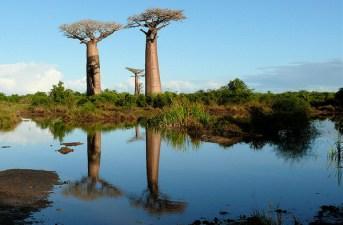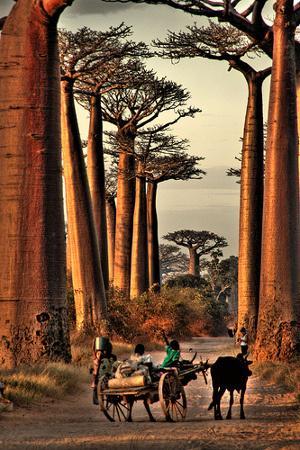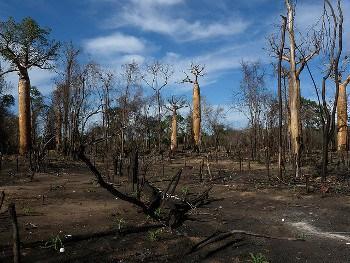
Photo: Baobab trees over water by Rita Willaert.
by John R. Platt / The Scientific American
The Ewe people of Togo, Africa, have a proverb: “Wisdom is like a baobab tree; no one individual can embrace it.” The proverb refers to the massive trees of the genus Adansonia that can live thousands of years, reach 30 meters into the sky and achieve trunk diameters of 10 meters or more. One baobab tree in South Africa is so large that a popular pub has been established inside its trunk. Many local cultures consider baobab trees to be sacred. Others use them for their nutritious fruits, edible leaves and beautiful flowers. In addition, old baobabs, like many long-lived trees, often have natural hollows in their trunks, which in their case can store tens of thousands of gallons of water—an important resource not just for the trees themselves but also for the people who live near them.
But the size and cultural value of baobab trees has not necessarily protected them. According to research published July 5 in Biological Conservation, two of Madagascar’s endemic baobab tree species will lose much of their available habitat in the next 70 years due to climate change and human development. One species may not survive to the next century. Madagascar is home to seven of the world’s eight baobab species, six of which can be found nowhere else.

The famous Avenue du Baobab by Alessandro Casagrande
The study—by scientists from the French agricultural research center CIRAD and the University of York in England—relied on satellite images and field work to develop population estimates and distribution models for three baobab species: Adansonia grandidieri, A. perrieri and A. suarezensis. All three trees are currently listed as endangered on the IUCN Red List, which has not reassessed any Adansonia species since 1998. The study suggests that two of the species should now be reclassified as critically endangered.
One of those species, A. perrieri, had the lowest current population, according to the study, with just 99 trees observed during ten years of field study. Based on its adaptation to specific geography and weather conditions, the researchers estimate that climate change will shrink the habitat of this species from about 21,000 square kilometers today to just over 6,500 square kilometers in 2080.
The second species, A. suarezensis, had a higher estimated current population of 15,000 trees but a far smaller distribution area of just 1,200 square kilometers. Based on climate change models and the species’s adaptation to high levels of precipitation, the researchers estimated that the distribution of this species will shrink to just 17 square kilometers by 2050 and could face potential extinction by 2080.
The one bright spot in their study was A. grandidieri, the largest and most populous baobab species. The researchers counted an estimated one million trees with a distribution of more than 26,000 square kilometers. According to their climate change models, this isn’t expected to change much by 2050 or 2080, but the team still recommends the species remain classified as endangered.

Slash-and-burn agriculture has destroyed many baobab habitats — and killed many baobab trees.
Unlike other species that may migrate or slowly move to new habitats as the climate shifts, baobab trees in Madagascar will not have that luxury. As the researchers point out, there’s nowhere left for the baobabs to go. Many baobab trees currently reside in Protected Area Networks (PANs) established to preserve Madagascar’s biodiversity, but the areas outside many PANs have been almost completely converted to agriculture or cattle grazing areas, leaving no room for the trees to expand their distribution. In addition, the large animal species such as elephant birds, which may have eaten baobab fruit and carried the trees’ seeds several kilometers from where they first fell, have all now gone extinct. With this in mind, the researchers assumed a “zero-colonization hypothesis” when calculating the trees’ distributions in coming decades, meaning they have little to no possibility of spreading to new habitats on their own.
Unfortunately, the baobabs may not be alone in this scenario. The researchers warn that baobab trees should be considered a case study and wrote that the existing PAN system in Madagascar “is not likely to be effective for biodiversity conservation in the future” because the PANs will not always contain the ecological features necessary for the survival of the species that live inside them today. They suggest that the PAN system will need to be adapted to reflect climate change models and the ecological features that various species will need in the coming decades, but warn that the rest of Madagascar’s ecology must also be reconsidered. As they wrote, “it is only with an integration of ecological, social and economic studies, involving local communities and stakeholders, that we have a hope of restoring [Madagascar's] ecosystem over the long term.”

